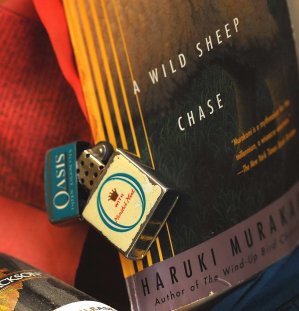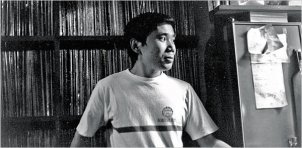The Murakami Mind Spiral
I read 353 pages of A Wild Sheep Chase (Vintage paperback; $15), closed it and said, “What was that about?” And then I went to Elliot Bay Book store in Seattle and bought five more Murakami titles.
Good old Haruk—Japan’s progressive literary gift to the western world, a psychological marksman slinging metaphysical darts. Shakespear he is not, but a reader often wades through one of these halucionary novels only to end up with a slap of modesty—ah, you thought you were a good reader, eh? Don’t think you arrived at that division circuitously; during a signing at Seattle’s Elliot Bay Book Store a woman asked Murakami about the significance and symbolism of an underwater volcano that appeared in one of the author’s short stories. Murakami replied, “Nothing. It symbolizes nothing. It’s whatever your want it to be.” Really? Are we to believe that Murakami’s works are aimless. I’m not buying in; as is the case with all great fiction you’ll follow your own path on A Wild Sheep Chase and draw individual conclusions. That can be a lonely state of affairs after 353 pages.
.With that said, you do want to read this book. Murakami often brings two major influences to the table. First are Murakami’s main characters, typically male, in their teens or twenties, mostly aloof, yet intellegent beer-drinking swines who are wound into some sort of random female relationship/relationships, occasionally with twisted and possibly illegal youth, a mix of Japanese schoolgirl/burasera tradition.
In addition, Murakami makes the fantastical believable, and despite a concerted effort to understand his method and implement it in my own work, I still don’t know how he makes talking cats, ghost-sheep, cat-killers and Kernel Sanders (as a pimp or as God) believable.
In A Wild Sheep Chase, Murakami’s unnamed narrator, a chain smoker, heavy drinker and aloof member of the human race, is as cool as they come. And I can sum up that factor with one example: to get home from the bar in the wee, dark hours, this character, who’s apartment is sparsely furnished and who’s refrigerator is mostly empty, memorizes the number of stairs on a long incline to his front door. No tripping here. Only pro drinkers need apply. In addition Murakami delivers a delicious young woman to his main character, a gal with paranormally endowed oversized ears. Yum.
The plot unfolds this way: In the beginning the main character, an ad executive, gets a postcard from a friend that includes the image of a sheep with a star marking on its back. The main character uses that image in an insurance company’s advertisement and unknowingly draws himself into a dangerous spiral. Soon, a man in black contacts our main character and delivers an ultimatum, find that sheep or suffer the consequences. While searching for said sheep, the main character meets the “Sheep Professor” and visits remote Japan where he holes up and languishes with a near-death fever and visits from the dead. Somehow the narrator patches the metaphysical into reality and implements changes in his life.
Like I said, this book could challenge your soul. I am not nearly skilled enough to deliver a full articulate answer to Murakami’s intentions, but I do know that I read A Wild Sheep Chase from one cover to the next with delight. It’s the figuring out part that becomes tedious. Take this book on your travels, take some time after fishing to read a bit. Draw conclusions, talk to fellow readers about it, join the blog and chat-room fray that Murakami’s works create, and then move on to the next Murakami project. That, by the way, was a warning: be prepared to embrace Murakami and spend the next six months going through his works.
Order A Wild Sheep Chase at http://www.borders.com/online/store/TitleDetail?sku=037571894X


